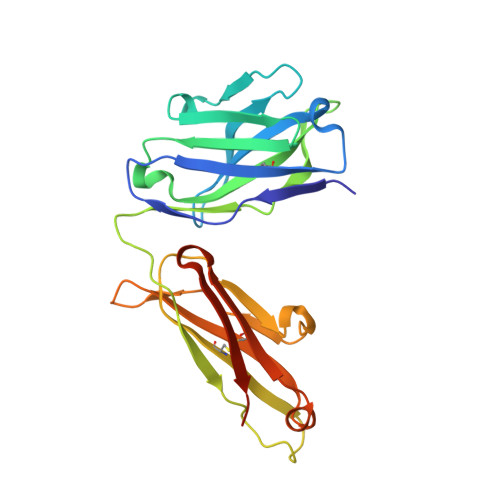Closely related antibody receptors exploit fundamentally different strategies for steroid recognition.
Verdino, P., Aldag, C., Hilvert, D., Wilson, I.A.(2008) Proc Natl Acad Sci U S A 105: 11725-11730
- PubMed: 18689687
- DOI: https://doi.org/10.1073/pnas.0801783105
- Primary Citation of Related Structures:
2O5X, 2O5Y, 2O5Z - PubMed Abstract:
Molecular recognition by the adaptive immune system relies on specific high-affinity antibody receptors that are generated from a restricted set of starting sequences through homologous recombination and somatic mutation. The steroid binding antibody DB3 and the catalytic Diels-Alderase antibody 1E9 derive from the same germ line sequences but exhibit very distinct specificities and functions. However, mutation of only two of the 36 sequence differences in the variable domains, Leu(H47)Trp and Arg(H100)Trp, converts 1E9 into a high-affinity steroid receptor with a ligand recognition profile similar to DB3. To understand how these changes switch binding specificity and function, we determined the crystal structures of the 1E9 Leu(H47)Trp/Arg(H100)Trp double mutant (1E9dm) as an unliganded Fab at 2.05 A resolution and in complex with two configurationally distinct steroids at 2.40 and 2.85 A. Surprisingly, despite the functional mimicry of DB3, 1E9dm employs a distinct steroid binding mechanism. Extensive structural rearrangements occur in the combining site, where residue H47 acts as a specificity switch and H100 adapts to different ligands. Unlike DB3, 1E9dm does not use alternative binding pockets or different sets of hydrogen-bonding interactions to bind configurationally distinct steroids. Rather, the different steroids are inserted more deeply into the 1E9dm combining site, creating more hydrophobic contacts that energetically compensate for the lack of hydrogen bonds. These findings demonstrate how subtle mutations within an existing molecular scaffold can dramatically modulate the function of immune receptors by inducing unanticipated, but compensating, mechanisms of ligand interaction.
- Department of Molecular Biology and The Skaggs Institute for Chemical Biology, The Scripps Research Institute, 10550 North Torrey Pines Road, La Jolla, CA 92037, USA.
Organizational Affiliation:



















